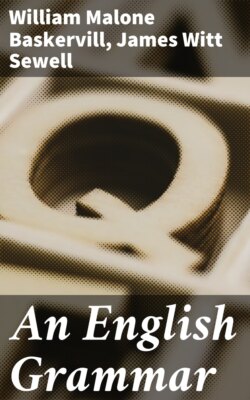Читать книгу An English Grammar - James Witt Sewell - Страница 38
На сайте Литреса книга снята с продажи.
Remarks on These Forms.
ОглавлениеTable of Contents
First and second persons without gender.
78. It will be noticed that the pronouns of the first and second persons have no forms to distinguish gender. The speaker may be either male or female, or, by personification, neuter; so also with the person or thing spoken to.
Third person singular has gender.
But the third person has, in the singular, a separate form for each gender, and also for the neuter.
Old forms.
In Old English these three were formed from the same root; namely, masculine hē, feminine hēo, neuter hit.
The form hit (for it) is still heard in vulgar English, and hoo (for hēo) in some dialects of England.
The plurals were hī, heora, heom, in Old English; the forms they, their, them, perhaps being from the English demonstrative, though influenced by the cognate Norse forms.
Second person always plural in ordinary English.
79. Thou, thee, etc., are old forms which are now out of use in ordinary speech. The consequence is, that we have no singular pronoun of the second person in ordinary speech or prose, but make the plural you do duty for the singular. We use it with a plural verb always, even when referring to a single object.
Two uses of the old singulars.
80. There are, however, two modern uses of thou, thy, etc.:—
(1) In elevated style, especially in poetry; as—
With thy clear keen joyance Languor cannot be; Shadow of annoyance Never came near thee; Thou lovest; but ne'er knew love's sad satiety. —Shelley.
(2) In addressing the Deity, as in prayers, etc.; for example—
Oh, thou Shepherd of Israel, that didst comfort thy people of old, to thy care we commit the helpless.—Beecher.
The form its.
81. It is worth while to consider the possessive its. This is of comparatively recent growth. The old form was his (from the nominative hit), and this continued in use till the sixteenth century. The transition from the old his to the modern its is shown in these sentences:—
1 He anointed the altar and all his vessels.—Bible
Here his refers to altar, which is a neuter noun. The quotation represents the usage of the early sixteenth century.
2 It's had it head bit off by it young—Shakespeare
Shakespeare uses his, it, and sometimes its, as possessive of it.
In Milton's poetry (seventeenth century) its occurs only three times.
3 See heaven its sparkling portals wide display—Pope
A relic of the olden time.
82. We have an interesting relic in such sentences as this from Thackeray: "One of the ways to know 'em is to watch the scared looks of the ogres' wives and children."
As shown above, the Old English objective was hem (or heom), which was often sounded with the h silent, just as we now say, "I saw 'im yesterday" when the word him is not emphatic. In spoken English, this form 'em has survived side by side with the literary them.
Use of the pronouns in personification.
83. The pronouns he and she are often used in poetry, and sometimes in ordinary speech, to personify objects (Sec. 34).
